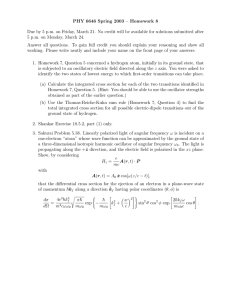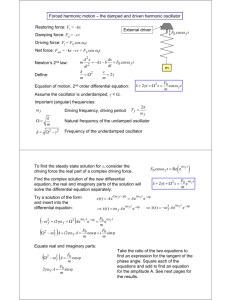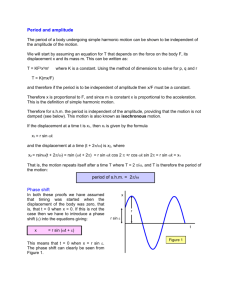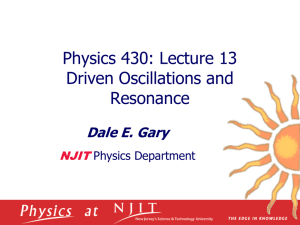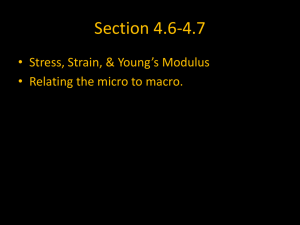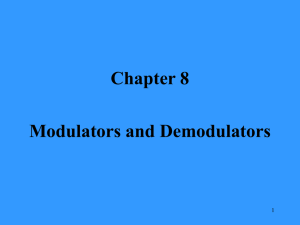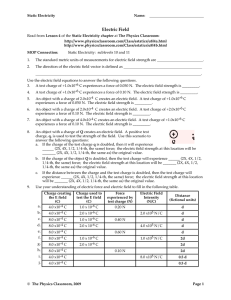Department of Basic Sciences ID: Group: 1
advertisement
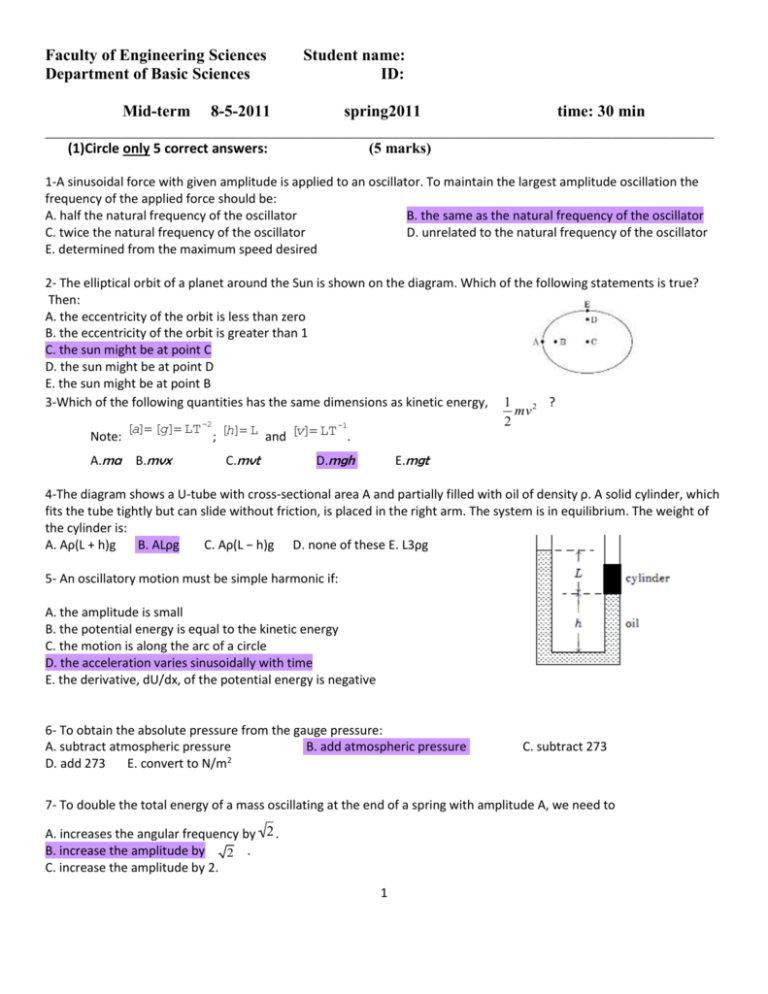
Faculty of Engineering Sciences Department of Basic Sciences Student name: ID: Mid-term 8-5-2011 spring2011 time: 30 min __________________________________________________________________________________ (1)Circle only 5 correct answers: (5 marks) 1-A sinusoidal force with given amplitude is applied to an oscillator. To maintain the largest amplitude oscillation the frequency of the applied force should be: A. half the natural frequency of the oscillator B. the same as the natural frequency of the oscillator C. twice the natural frequency of the oscillator D. unrelated to the natural frequency of the oscillator E. determined from the maximum speed desired 2- The elliptical orbit of a planet around the Sun is shown on the diagram. Which of the following statements is true? Then: A. the eccentricity of the orbit is less than zero B. the eccentricity of the orbit is greater than 1 C. the sun might be at point C D. the sun might be at point D E. the sun might be at point B 3-Which of the following quantities has the same dimensions as kinetic energy, 1 ? mv 2 2 -1 [a] [g] LT -2 [h] L Note: ; and [v] LT . A.ma B.mvx C.mvt D.mgh E.mgt 4-The diagram shows a U-tube with cross-sectional area A and partially filled with oil of density ρ. A solid cylinder, which fits the tube tightly but can slide without friction, is placed in the right arm. The system is in equilibrium. The weight of the cylinder is: A. Aρ(L + h)g B. ALρg C. Aρ(L − h)g D. none of these E. L3ρg 5- An oscillatory motion must be simple harmonic if: A. the amplitude is small B. the potential energy is equal to the kinetic energy C. the motion is along the arc of a circle D. the acceleration varies sinusoidally with time E. the derivative, dU/dx, of the potential energy is negative 6- To obtain the absolute pressure from the gauge pressure: A. subtract atmospheric pressure B. add atmospheric pressure 2 D. add 273 E. convert to N/m C. subtract 273 7- To double the total energy of a mass oscillating at the end of a spring with amplitude A, we need to A. increases the angular frequency by 2 . B. increase the amplitude by 2 . C. increase the amplitude by 2. 1 D. increase the angular frequency by 2. E. increase the amplitude by 4 and decrease the angular frequency by 1 . 2 8-A body oscillates with simple harmonic motion along the x axis. Its displacement varies with time according to the equation x = 5 sin (t + /3). The phase (in rad) of the motion at t = 2 s is A. 7/3 (2) Proof B. /3 only two of the following C. D. 5/3 (5 marks) : 1- Prove Kepler's 2 nd law, dA/dt=L / 2Mp= constant Geometrically, in a time dt, the radius vector r sweeps out the area dA, which is half the area of the parallelogram dA = 1 |r x dr| 2 Its displacement is given by dr = vdt dA 1 r x vdt 2 The gravitational force exerted by the Sun on the planet is a central force. The force produces no torque, so angular momentum is a constant. L = r x p = MPr x v = constant L r x v constant Mp L dA dt 2M p dA L constant dt 2M p 2-prove that the periodic time of simple pendulum is given by: T=2π√L/g The forces acting on the bob are the tension and the weight T is the force exerted on the bob by the string, mg is the gravitational force 2 E. 2 The tangential component of the gravitational force is a restoring force In the tangential direction, Ft mat mg sin m d 2s dt 2 & s=Lθ The length, L, of the pendulum is constant, and for small values of θ d 2 g g sin 2 dt L L This confirms the mathematical form of the motion is the same as for SHM. The angular frequency is The period is T 2 2 L g g L 3- For a simple harmonic oscillator, prove that the total energy is given by, E=1/2 kA2 Start with x= A cos(ωt+φ) x= A cos(ωt+φ) v=dx/dt= -ωA sin(ωt+φ) Etotal=Kinetic energy + Potential energy=1/2 mv2+1/2 kx2 =1/2 m(ωA sin(ωt+φ))2+1/2 k (A cos(ωt+φ))2 =1/2 A2(mω2+k)( sin2(ωt+φ)+ cos2(ωt+φ)) ω2=k/m Etotal =1/2 kA2 (10 marks) (3)Solve only two problems of the following: 1-Assume that it takes 7.00 minutes to fill a 30.0-gal gasoline tank. (A) calculate the rate at which the tank is filled in gallons per second. (B) Calculate the rate at which the tank is filled in cubic meters per second. (C) Determine the time interval, in hours, required to fill a 1-m3 volume at the same rate. (1 U.S. gal= 231 in.3, in.= 2.31 cm) Important: Take into consideration the significant figures (a) The rate in gallons per second = 30.0/(7.00 x 60)=7.1x10-3 gal/s (B) 1 gal= 231 in.3 = 231x(2.31)3 cm3 = 231x(2.31)3 x10-6 m3= 2.85x10-3 m3 The rate in cubic meters per second = 7.1x10-3 x 2.85x10-3 = 2.0x10-5 m3/s (C) The full rate = volume /time time = volume /full rate = 1/(2.0x10-5)= 50x103 s =50x103/(60x60) =14 h 3 2- Water flowing through a garden hose of diameter 2.74cm fills a 25 L bucket in 1.50 min (a) what is the speed of the water leaving the end of the hose (b)a nozzle is now attached to the end of the hose if the nozzle diamter is one third the diameter of the hose what is the speed of the water leaving the nozzle? The volume flow rate = V/t = 25x10-3/(1.50x60)= 2.8 x10-4 m3/s A = πr2 = π (2.74x10-2/2)2 = 5.90 x10-4 m2 V: volume, v: speed and A: cross sectional area (a) The volume flow rate =Av v = 2.8 x10-4/5.90 x10-4 =0.47 m/s (b) r2 = r/3 So, A2 = A/9 or A/ A2 = 9 The volume flow rate =Av =A2.v2 v2 = vA/A2 = 9 v = 9x0.47= 4.2 m/ss 3- Mercury is poured into a U-tube as in Fig.(a) The left arm of the tube has cross-sectional area A1 of10.0 cm2, and the right arm has a cross-sectional area A2 of 5.00 cm2. One hundred grams of water are then poured into the right arm as in Fig.(b) a) Determine the length of the water column in the right arm of the U-tube. b) Given that the density of mercury is 13.6 g/cm3, what distance h does the mercury rise in the left arm? (a) The mass of water( mw) = ρwV= ρwA hw hw= mw/( ρwA)= 100/(1x5.00) = 20 cm (b) P1=P2 Pa+ ρm.g.hm= Pa+ ρw.g.hw ρm.hm= ρw.hw hm= hw ρw /ρm = 20x1/13.6=1.47 cm hm= h1+ h2 But A1h1=A2h2 h2=h1 A1/ A2= h1x10.0/5.00=2 h1 hm =h1 + h2= h1 + 2h1 =3h1 h1 =hm/3=1.47/3=0.49 cm 4- A 200 g block connected to a light spring for which the force constant is 5.00 N/m is free to oscillate on frictionless horizontal surface .the block is displaced 5.00cm from equilibrium and released from rest Find: 4 (a) (b) (c) (d) (a) the period of the motion. The maximum speed of the block The maximum acceleration of the block Express the position, velocity and acceleration as functions of time in SI units. k 5.00 5 rad / s m 200 x10 3 2 2 2 T 1.3 s T 5 (b) vmax= Aω=5x10-2x5=25x10-2 m/s (c) amax= Aω2=5x10-2x52=125x10-2 m/s2 (d) From the initial conditions: At t=0, x= 5 cm x= A cos(ωt+φ) 5=5 cos(5.(0)+φ)= cos(φ) cos(φ)=1 So φ=0 x= 0.05 cos(5t) v= -0.25 sin(5t) a= -1.25 cos(5t) 5
